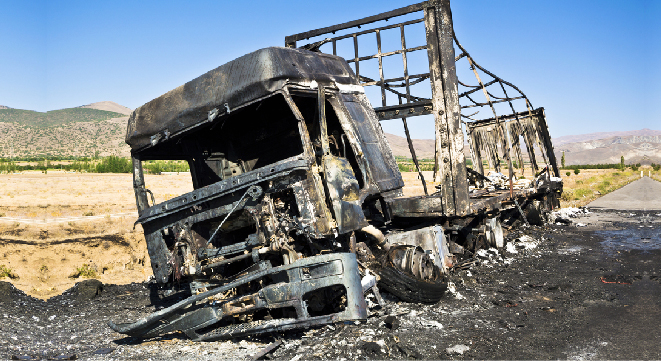Consumers are justifiably concerned about the impact of Eskom’s demand for a 20% tariff increase, but there’s another factor that could contribute to rising inflation this year: significantly higher Sasria rates on commercial vehicles.
Sasria announced its 2022 rates in September last year. The new rates take effect from 1 February.
Although there were no rate increases for certain classes of business, including domestic fire and cars for private use, massive increases will apply, in particular, to commercial vehicles.
The biggest rate increase, a whopping 1 736%, is on heavy commercial vehicles (those with a gross vehicle mass above 3 500kg). The rate increases from 0.01879% per R1 of cover a year to 0.345057%. This means the annual Sasria premium on an HCV insured for R2 million will increase from R375.80 to R6 901.14 (including VAT), while on an HCV insured for R500 000, the premium will jump from R93.95 to R1 725.28.
Light commercial vehicles (GVM of 3 500kg or less) were charged a flat rate of R45.39 (including VAT). This will change to a rate of 0.070621% per R1 of cover. This will result in the premium on an LCV insured for R1m climbing to R706.21, an increase of 1 455%.
Gavin Kelly, the chief executive of the Road Freight Association, said these costs will have to be passed on to the consumer.
Whereas Sasria cover was a relatively minor component of the trucking industry’s costs, they have now become significant, he said.
Road freight operators are obviously unhappy about the increases, particularly because they resulted from a risk over which companies have no control: the ongoing attacks on trucks, Kelly said. The government should ensure that trucks are adequately protected.
In a sense, trucking companies are being “punished” – via expensive Sasria cover – for something that shouldn’t be happening.
Kelly said the higher Sasria premiums, as well as the seeming lack of will to act decisively against the attacks on trucks, may result in some operators exiting the industry. Furthermore, operators that transport goods to neighbouring countries could decide to by-pass South African ports, which are becoming inefficient.
It’s not only road transport companies that will feel the brunt of the increases. There was an outcry from agricultural organisations, as the higher rates will apply to certain types of farm vehicles, including harvesters, self-propelled sprayers and planters.
“If the rationale behind the drastic increase is based on the damage done to commercial trucks transporting cargo for compensation during the July 2021 riot, this unjustified increase, which would apply to agricultural equipment which would almost never be exposed to this type of risk, simply does not make sense, and the classification of this type of equipment should be re-considered,” Francois Wilken, the president Free State Agriculture, said.
Moonstone has been told that the call for an alternative classification of agricultural vehicles has not gone unheeded. Discussions involving Sasria, insurers and the agricultural sector about creating a rating class for agriculture are apparently at an advanced stage.
‘Not because of July unrest’
Although the July unrest is frequently cited as the reason for the rate hikes, Sasria said this was not the case.
“The affected lines of business have traditionally been affected by high frequency and severity [of] claims,” it said.
The Financial Intermediaries Association of Southern Africa (FIA) agrees. It said the classes of business impacted by the increase have historically underperformed for three years, to such an extent that it placed the overall portfolio in jeopardy.
“The July riot was not the trigger for the review. The rate review exercise is conducted annually to review the adequacy of the rates against the risks posed. The only impact the July event had on the rate is a minimal allocation for the reinsurance costs increase,” the FIA said.
New rate for office buildings
Sasria created two rating categories for the F2 Fire Commercial class of business in recognition of the lower risk profile of office premises compared with other commercial premises. The rate for the new Fire Commercial Office category is 0.02088%, which is 20% more than the 2021 Fire Commercial rate.
However, the annual rate for non-office commercial premises increases by a massive 67%, from 0.0174% per R1 of cover to 0.029058%.
This means Sasria cover on a R20m office building will cost R4 176, whereas cover on a warehouse insured for the same amount will cost R5 812.
Sasria said the Fire Commercial class of business was among the hardest hit in terms of severity of claims.
Another change this year is the introduction of the municipal (MUM) class of business, which is a result of what Sasria called the “claims volatility” on municipalities.
Municipal-related risks, which fell under the F2 Fire Commercial, will now move to MUN. The annual rate is 0.02958%, which is 1.79% higher than the 2022 rate for Fire Commercial (non-office).
Asked whether there was anything insurers could do to mitigate the impact of the rates increase, the FIA said Sasria was finalising a proposal from the FIA to implement voluntary excess and co-insurance options to allow for a discount on the premium.
Insurers that provide cover for the commercial transport sector were asked the same question, but they declined to comment.




i do not agree with some opinions. Everybody can see this is not a mathematically derived sum.
Eish!!